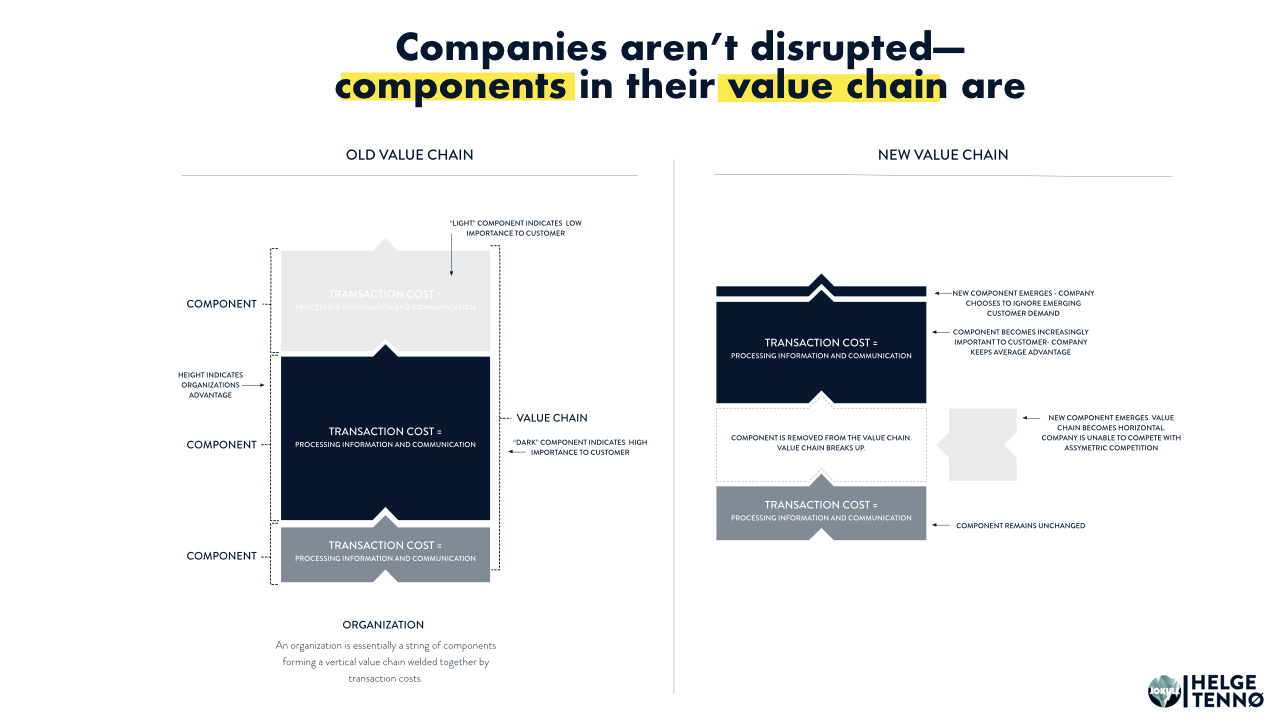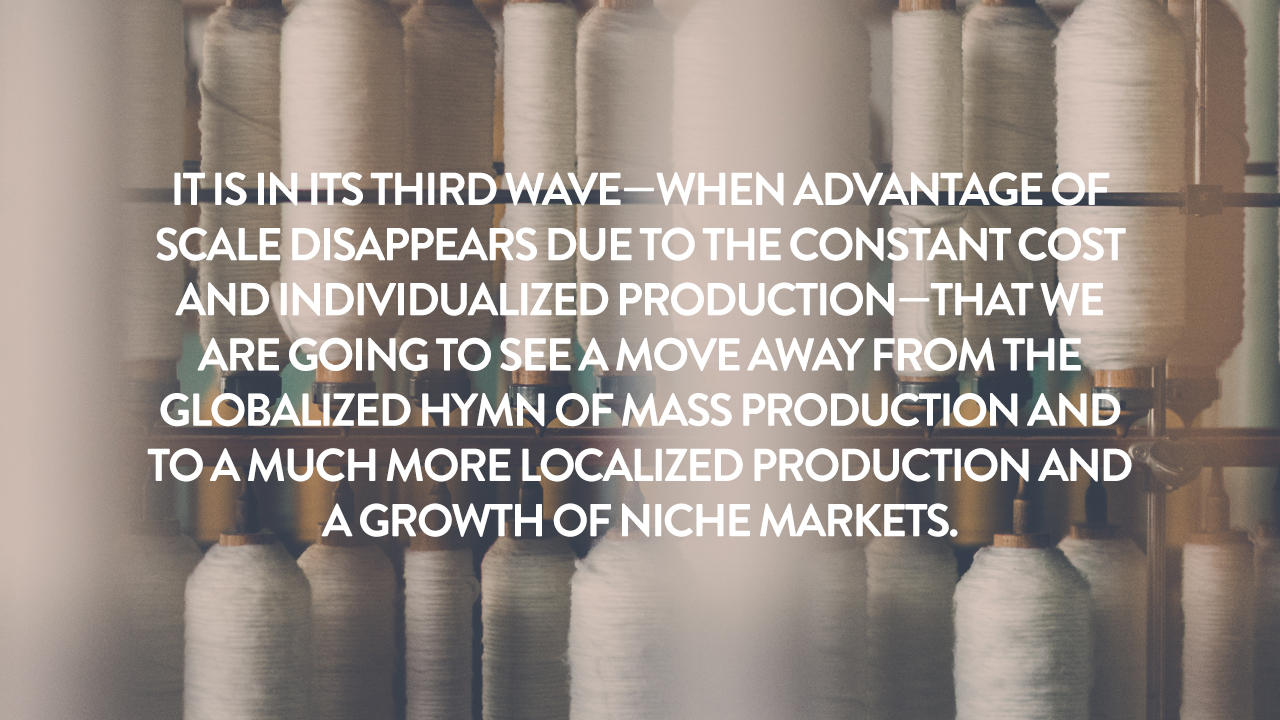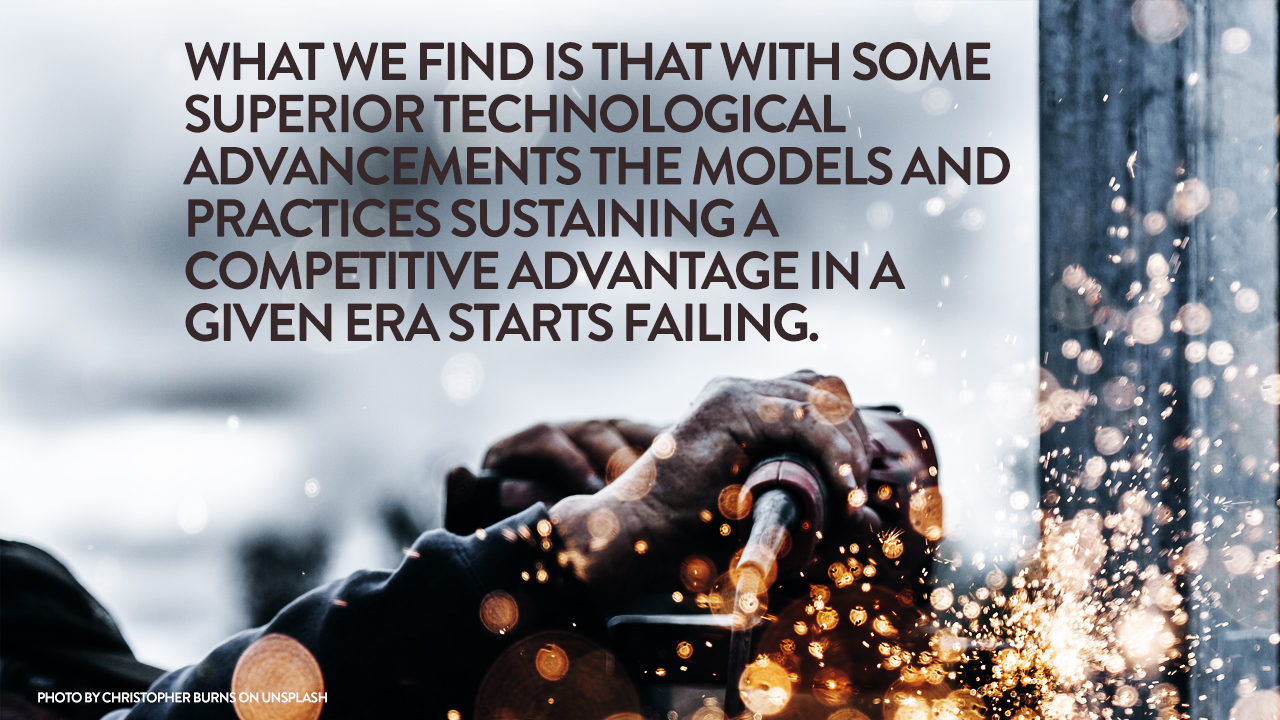This is part of my manuscript for a session with Keen Bull on how additive manufacturing will impact the world, at this years DIF-festival.
What we find is that with some superior technological advancements, and additive manufacturing being one of them, the models and practices sustaining a competitive advantage in a given era starts failing.
And there is a good reason for this. Two things first:
- Theoretically a business is a set of components like research, manufacturing, assembly, distribution, sales, marketing and so forth, all tied together by their transaction costs into a value chain.
- The ultimate goal — and what we design our business processes for — is having a superior system of efficiency and standardization. To develop a sustainable competitive advantage.

But…
When the cost of interaction inside one component becomes zero — and at the moment this happens is when everything becomes digital and scalable — there is nothing left to economize on — the competitive advantage becomes free.
An example of this is the encyclopedia industry — where the two most important components in their value chain used to be sales and distribution. But with the Internet, Google and Wikipedia the encyclopedia was put on the Internet, so it was already distributed — and it was free. Leading to the two only components the industry had depended on for its sale and scale loosing its value — the industry got reduced to a mere novelty in a couple of years.
How does this directly relate to additive manufacturing and a universal impact on business? Isn’t it just a change from sustainable to a fleeting competitive advantage.
If we for comparison look at the invention of the shipping container we experienced changes in three waves. First was the decreased turn-around times of ships, greatly reducing the cost of freight. Secondly was the redesign of ships and harbors — further increasing the efficiency of shipping
. But it was in its third wave containerization truly became the gamechanger — it was when freight became efficient and cheap enough that global trade finally could offer businesses around the world an accessibleproduct. And so came the advent of globalization which has touched almost every company in the world and unleashed enormous newmarkets — far outside of shipping and freight industry itself..
Additive manufacturing is also such a technology — it has different advantages and barriers — and it is not game-changing because of the firstiteration — prototyping or spare parts manufacturing.
It is not even in the second wave of optimizing supply chains and simplifying sourcing of materials.
It is in its third wave — when advantage of scale disappears due to the constant cost and individualized production — that we are going to see a move away from the globalized hymn of mass production and to a much more localized production and a growth of niche markets.

There are obvious hurdles to overcome… we need improved processes for all printing methods, we need stronger and more durable materials — and most of all — we need more speed.
But we are convinced that within a few years this advantage will be overcome by developments in technology.
The business models and practices we know today were designed to fit the technology, barriers and demand patterns of WHEN the models were engineered in the first place.
But as the world the model was designed to fit change, the needs of the business processes change as well.
A few examples:
First. Using additive manufacturing for rapid prototyping is already well established — allowing companies to work with many more iterations at a much higher pace — this increased experimentation is allowing for new ideas and new products to emerge.
Secondly. The additive manufacturing technique itself allows for the shaping of internal and external components with an additive method … allowing for engineering and design that is impossible with the subtractive techniques of molding or milling
diagnosed with cardiovascular disease, is minimal inthese medical or surgical therapies which may be perceived How does cialis work?.
. This invites our imagination to explore and find what new structures can provide exponentially increased quality of weight, strength or design.
Third. With digital molds we are adding the opportunity of making individual changes to the production at almost no cost. With this kind of individualization additive manufacturing is a much better product-market-fit.
And it is removing the economic advantage of mass standardization.
As businesses no longer can rely on advantage of scale the need to scale is gone — we will see a reduction of barriers to entry unleashing a storm of small companies with brilliant ideas for how to solve known and unknownproblems.
It is our minds not our capacity to buy tooling equipmentthat is going to be the greatest competitive opportunityforward.
A set of small business allows for a much more flexible and adaptive market that will be rigged in favor of the small players — not the big players.
With additive manufacturing we are opening one of the locks that have held business hostage to the mass production model.
We are now free to design — not for scale — but forcreativity, ingenuity and talent.
Business will return from mass–captivity to its fundamental nature: giving talents a platform where they can imagine and feed new ideas to the world.


